2008 Pacific hurricane season
The 2008 Pacific hurricane season was a near average hurricane season. It officially started May 15, 2008 in the eastern Pacific, started on June 1, 2008 in the central Pacific, and lasted until November 30, 2008. This season is the first since 1996 to have no cyclones cross into the central Pacific.[1] Activity this year was near average, with 16 storms forming in the Eastern Pacific proper and an additional 1 in the Central Pacific. There were 7 hurricanes, a low number compared to the typical 9, and only 2 major hurricanes, unlike the typical 5. There were only a few notable storms this year. Tropical Storm Alma made landfall along the Pacific coast of Nicaragua, becoming the first known storm to do so. It killed 9 and did US$35 million in damage (value in 2008). It also became the first tropical storm to be retired in the Eastern Pacific basin. Hurricane Norbert became the strongest hurricane to hit the western side of the Baja Peninsula on record, killing 25.
| 2008 Pacific hurricane season | |
|---|---|
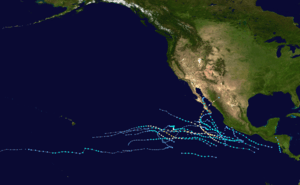 Season summary map | |
| Seasonal boundaries | |
| First system formed | May 29, 2008 |
| Last system dissipated | November 5, 2008 |
| Strongest storm | |
| Name | Norbert |
| • Maximum winds | 130 mph (215 km/h) (1-minute sustained) |
| • Lowest pressure | 945 mbar (hPa; 27.91 inHg) |
| Seasonal statistics | |
| Total depressions | 19 |
| Total storms | 17 |
| Hurricanes | 7 |
| Major hurricanes (Cat. 3+) | 2 |
| Total fatalities | 46 total |
| Total damage | $152.2 million (2008 USD) |
| Related articles | |
Seasonal summary
| Record | Named storms |
Hurricanes | Major hurricanes |
Ref | |
|---|---|---|---|---|---|
| Average (1971-2005): | 14.5 | 8.4 | 4.3 | [2] | |
| Record high activity: | 1992: 27 | 2015: 16 | 2015: 11 | [3] | |
| Record low activity: | 2010: 8 | 2010: 3 | 2003: 0 | [3] | |
| Date | Source | Named storms |
Hurricanes | Major hurricanes |
Ref |
| May 16, 2008 | SMN | 15 | 7 | 2 | [4] |
| May 22, 2008 | CPC | 11–16 | 5–8 | 1–3 | [5] |
| Area | Named storms | Hurricanes | Major hurricanes | Ref | |
| Actual activity: | EPAC | 16 | 7 | 2 | |
| Actual activity: | CPAC | 1 | 0 | 0 | |
| Actual activity: | 17 | 7 | 2 | ||
Preseason forecast
On May 16, 2008, the Servicio Meteorológico Nacional posted their outlook for the 2008 Pacific hurricane season, forecasting 15 named storms, 7 hurricanes, and 2 major hurricanes.[4] Three days later, the National Oceanic and Atmospheric Administration's Central Pacific Hurricane Center released their forecast for the central Pacific, predicting three or four tropical cyclones to form or cross into the basin; an average season sees four or five tropical cyclones, of which two further intensify into hurricanes.[6] On May 22, meanwhile, the Climate Prediction Center released their outlook, forecasting a 70 percent probability of a below-average year, a 25 percent chance of a near-average year, and only a 5 percent chance of an above-average year. The organization predicted 11–16 named storms, 5–8 hurricanes, 1–3 major hurricanes, and an Accumulated Cyclone Energy (ACE) index 40–100 percent of the long-term median. All three groups cited the effects of the ongoing La Niña, as well as the continuation of a multi-decadal decline in Pacific hurricane activity, as their reasoning behind the below-average forecasts.[5]
Seasonal activity
The 2008 Pacific hurricane season was relatively quiet overall, with 16 named storms, 7 hurricanes, 2 major hurricanes, and an ACE index of 83 units in the East Pacific; 1 tropical storm formed in the Central Pacific. The main contributing factor to a slower season was the 2007–08 La Niña event in the equatorial Pacific; although cold ocean temperature anomalies dissipated during the early summer of 2008, a La Niña-like atmospheric circulation persisted. This led to anomalously strong easterly wind shear across the East Pacific, hindering the intensification of most tropical cyclones. In addition, water temperatures across the basin were cooler than in years past, though still near the long-term average. The first storm of the year, Alma, developed on May 29 farther east than any other East Pacific cyclone in recorded history, not including storms that originated in the Atlantic and continued into the basin. Later that day, it made landfall on the Pacific coast of Central America, the first cyclone to do so since the 1949 Texas hurricane. June and July saw near average tropical cyclone activity, while August was a below-average month overall. September 2008 was the quietest since reliable records began in 1971, with a monthly ACE index only 9 percent of average. In terms of ACE, seasonal activity ended about 75 percent of the long-term median.[7]

Systems
Tropical Storm Alma
| Tropical storm (SSHWS) | |
  | |
| Duration | May 29 – May 30 |
|---|---|
| Peak intensity | 65 mph (100 km/h) (1-min) 994 mbar (hPa) |
A nearly stationary trough of low pressure formed over the extreme eastern Pacific in late May, and the system organized into a tropical depression around 00:00 UTC on May 29, becoming the easternmost-forming tropical cyclone on record in the basin. The newly-formed system intensified into a tropical storm six hours later, earning the name Alma, and attained peak winds of 65 mph (100 km/h) around 18:00 UTC as an eye-like feature became apparent on satellite. Moving northward, Alma made landfall near León, Nicaragua, at that strength before rapidly weakening inland. Its low-level circulation dissipated over the mountains of western Honduras around 18:00 UTC on May 30, but remnant convective activity aided in the formation of Tropical Storm Arthur in the western Caribbean a day later.[8]
Alma produced devastating rainfall across Central America, with peak accumulations of 14.82 in (376.4 mm) in Quepos, Costa Rica. The nearby cities of Guanacaste and Puntarenas were most heavily affected with over 1,000 homes damaged, of which over 150 were destroyed. Throughout all of Costa Rica, more than 100 roads and bridges were damaged, leaving several communities isolated for several days. In Nicaragua, the departments of León and Chinandega saw approximately 200 homes damaged; across Honduras, an additional 175 homes were adversely impacted. Six people died in Honduras: a young girl who was swept away by a fast-moving river and five people who perished following the crash of TACA Flight 390. Two more deaths occurred in Nicaragua due to electrocutions from downed power lines, and one death occurred offshore when a fishing vessel sank. Nine people on boats went missing in the wake of the cyclone.[8]
Hurricane Boris
| Category 1 hurricane (SSHWS) | |
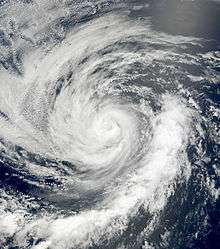  | |
| Duration | June 27 – July 4 |
|---|---|
| Peak intensity | 80 mph (130 km/h) (1-min) 985 mbar (hPa) |
A westward-moving tropical wave departed the western coast of Africa on June 14 and entered the eastern Pacific a week later. A broad surface low formed in association with the feature south of the Gulf of Tehuantepec on June 23, and its organization led to the development of a tropical depression around 06:00 UTC on June 27. The cyclone only slowly organized in a moderate wind shear regime, becoming Tropical Storm Boris six hours later and remaining fairly steady state for a few days thereafter. Shear lessened on June 29, allowing Boris to attain hurricane intensity two days later as an eye developed. This feature was temporarily eroded late on July 1, but reappeared by 06:00 UTC on July 2 when the cyclone attained peak winds of 80 mph (130 km/h). Cold waters and a more stable environment then prompted rapid weakening, and Boris ultimately degenerated to a remnant low by 12:00 UTC on July 4. The post-tropical cyclone continued westward until dissipating early on July 6.[9]
Tropical Storm Cristina
| Tropical storm (SSHWS) | |
  | |
| Duration | June 27 – June 30 |
|---|---|
| Peak intensity | 50 mph (85 km/h) (1-min) 999 mbar (hPa) |
The season's third tropical depression developed around 18:00 UTC on June 27 from a tropical wave that crossed Central America four days prior. In an environment of low shear but abundant dry air and marginal ocean temperatures, the depression intensified into Tropical Storm Cristina around 12:00 UTC on June 28 before attaining peak winds of 50 mph (85 km/h) six hours later. The cyclone moved west-northwest and then west as high pressure expanded to its north. Abundant dry air and stronger upper-level winds capped the storm's organization to intermittent, amorphous bursts of convection that eventually dissipated, and Cristina degenerated to a remnant low around 18:00 UTC on June 30. The low turned southward before dissipating on July 3.[10]
Tropical Storm Douglas
| Tropical storm (SSHWS) | |
  | |
| Duration | July 1 – July 4 |
|---|---|
| Peak intensity | 40 mph (65 km/h) (1-min) 1003 mbar (hPa) |
An organized tropical wave departed the western coast of Africa on June 19 and reached the waters south of the Gulf of Tehuantepec late the next week. The system steadily congealed into a tropical depression by 18:00 UTC on July 1. Paralleling the coastline of southwestern Mexico, the depression intensified into Tropical Storm Douglas and attained peak winds of 40 mph (65 km/h) around 12:00 UTC the next morning, despite the effects of strong northeasterly wind shear. As upper-level winds increased further and Douglas tracked northwest into cooler waters, it began a weakening trend that ended in its degeneration to a remnant low around 06:00 UTC on July 4. The low turned west within low-level flow and dissipated two days later.[11]
Due to the proximity to land, outer rain bands associated with Douglas produced tropical storm force winds in Manzanillo, Mexico.[11] Minor flood damage was reported along the coastline in Colima, Jalisco, and Nayarit.[12] Due to the proximity to land, the outer bands of Douglas produced tropical storm force winds in Manzanillo, Mexico.[11] Minor flooding was reported along the coastline in Colima, Jalisco, and Nayarit.[12] Moisture associated with Douglas produced light rain over parts of Baja California Sur, with heavier amounts in Todos los Santos.[13]
Tropical Depression Five-E
| Tropical depression (SSHWS) | |
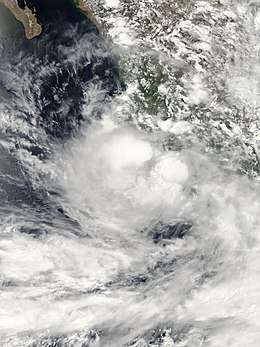 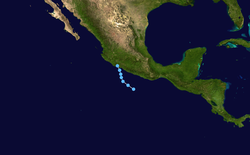 | |
| Duration | July 5 – July 7 |
|---|---|
| Peak intensity | 35 mph (55 km/h) (1-min) 1005 mbar (hPa) |
A tropical wave departed the western coast of Africa on June 23 and began steady organization after entering the eastern Pacific over a week later. The system acquired sufficient organization to be declared a tropical depression around 18:00 UTC on July 5 and embarked on a northwesterly course parallel to the coastline of Mexico. The following day, however, a weakening mid-level ridge to its north directed the cyclone more poleward.[14] Strong easterly wind shear prevented the formation of banding features while keeping the overall cloud pattern disorganized,[15] and the depression moved ashore near Lázaro Cárdenas, Michoacán, early on July 7 without attaining tropical storm intensity. It dissipated over the mountainous terrain a few hours later.[14]
Hurricane Elida
| Category 2 hurricane (SSHWS) | |
  | |
| Duration | July 11 – July 19 |
|---|---|
| Peak intensity | 105 mph (165 km/h) (1-min) 970 mbar (hPa) |
A tropical wave, indistinguishable in the Atlantic basin, crossed the coastline of Central America on July 8 and organized into a tropical depression three days later around 18:00 UTC. With a mid-level ridge extending from the Gulf of Mexico into western Mexico, the newly-formed cyclone moved west-northwest within an increasingly favorable environment, intensifying into Tropical Storm Elida by 06:00 UTC on July 12 and becoming the season's first hurricane around 12:00 UTC on July 14. An abrupt increase in wind shear briefly weakened the storm the next day, but by 18:00 UTC on July 16,[16] the formation of an eye within Elida's round central dense overcast showcased its peak as a Category 2 hurricane with winds of 105 mph (165 km/h).[17] The system then tracked into cooler waters and stronger upper-level winds, causing it to fall below hurricane intensity by 06:00 UTC on July 18 and degenerate to a remnant low early the next morning, although it maintained a well-defined circulation. The low ultimately dissipated well east-southeast of Hawaii by 00:00 UTC on July 22.[16]
Hurricane Fausto
| Category 1 hurricane (SSHWS) | |
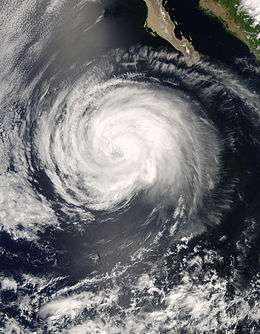 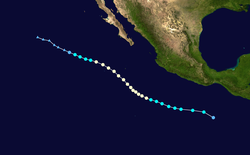 | |
| Duration | July 16 – July 22 |
|---|---|
| Peak intensity | 90 mph (150 km/h) (1-min) 977 mbar (hPa) |
Fausto developed from a tropical wave that departed Africa on July 4 and entered the eastern Pacific eight days later. There, the disturbance steadily organized into a tropical depression around 06:00 UTC on July 16. After formation, the cyclone moved swiftly west-northwest, steered by a mid-level ridge to its north. Favorable environmental conditions allowed it to intensify into Tropical Storm Fausto six hours after formation and further strengthen into a hurricane by 12:00 UTC on July 18. The storm unexpectedly leveled off the next day, but Fausto ultimately attained its peak as a Category 1 hurricane with winds of 90 mph (150 km/h) around 12:00 UTC on July 20 as its eye became most distinct in infrared satellite imagery;[18][19] this value is slightly lower than its originally-assessed peak of 100 mph (155 km/h). Entering progressively cooler waters, the storm weakened below hurricane intensity late on July 21 and ultimately degenerated to a remnant low by 00:00 UTC on July 23. The post-tropical cyclone dissipated the next day.[18]
Clarion Island reported sustained winds of 64 mph (103 km/h), gusting to 94 mph (151 km/h), and Socorro Island reported sustained winds of 79 mph (127 km/h), gusting to 109 mph (175 km/h) at the height of Fausto. However, considering the storm's nearest approach brought it no closer than 115 mi (185 km) to the islands, these values are deemed suspect by the NHC.[18]
Hurricane Genevieve
| Category 1 hurricane (SSHWS) | |
 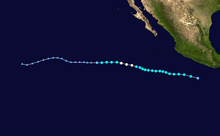 | |
| Duration | July 21 – July 27 |
|---|---|
| Peak intensity | 75 mph (120 km/h) (1-min) 987 mbar (hPa) |
A tropical wave moved off Africa on July 6, spawning an area of low pressure over the western Caribbean Sea ten days later. After crossing into the eastern Pacific, the disturbance organized into a tropical depression around 12:00 UTC on July 21 and intensified into Tropical Storm Genevieve six hours later. Moderate easterly wind shear gave way to more favorable upper-level winds following formation, but the system soon tracked over cooler ocean waters caused by Hurricane Fausto, limiting its development. By July 25, however, Genevieve moved into warmer waters and attained its peak as a Category 1 hurricane with winds of 75 mph (120 km/h);[20] its satellite presentation at this time was characterized by hints of an eye within a small central dense overcast.[21] Encountering strong northerly wind shear, the cyclone began a steady weakening trend shortly thereafter and ultimately degenerated to a remnant low around 12:00 UTC on July 27. The low continued west and dissipated four days later.[20]
Hurricane Hernan
| Category 3 hurricane (SSHWS) | |
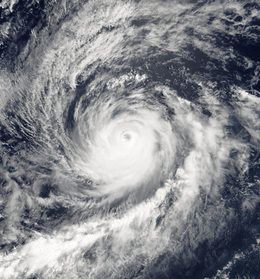 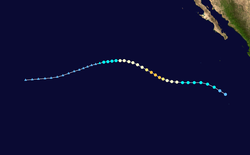 | |
| Duration | August 6 – August 12 |
|---|---|
| Peak intensity | 120 mph (195 km/h) (1-min) 956 mbar (hPa) |
A tropical wave departed Africa on July 24, moving inconspicuously across the Atlantic before entering the eastern Pacific on August 2. There, it merged into a broader area of cyclonic flow, generating an area of low pressure that subsequently organized into a tropical depression around 12:00 UTC on August 6. Twelve hours later, it intensified into Tropical Storm Hernan. The newly-formed storm gradually strengthened despite moderate east-northeasterly wind shear. Early the next day, upper-level winds relaxed and allowed Hernan to begin a period of rapid intensification. It attained hurricane strength by 12:00 UTC on August 8 and further strengthened to its peak as a Category 3 hurricane with winds of 120 mph (195 km/h) around 12:00 UTC on August 9. After peak, Hernan underwent an eyewall replacement cycle and also entered cooler waters, resulting in it weakening to a tropical storm around 00:00 UTC on August 12. Convection gradually dissipated and Hernan degenerated to a remnant low a day later. The post-tropical cyclone moved west-southwest before dissipating well southeast of Hawaii on August 16.[22]
Tropical Storm Kika
| Tropical storm (SSHWS) | |
  | |
| Duration | August 7 – August 12 (Crossed basin) |
|---|---|
| Peak intensity | 40 mph (65 km/h) (1-min) 1007 mbar (hPa) |
The Central Pacific Hurricane Center first began monitoring a small area of convection well southeast of Hawaii on August 4. A strong ridge to its north steered the disturbance westward, while environmental conditions allowed for gradual organization into a tropical depression by 00:00 UTC on August 7. Six hours later, it intensified into Tropical Storm Kika. Despite generally light wind shear, Kika became disorganized on August 8 as its center reformed south of its associated deep convection; it fell to tropical depression strength around 18:00 UTC that day, only to re-attain tropical storm intensity twelve hours later. Cooler waters prevented Kika from intensifying beyond 40 mph (65 km/h), and eventually caused the storm to degenerate to a remnant low by 12:00 UTC on August 12 before it crossed the International Date Line.[23]
Tropical Storm Iselle
| Tropical storm (SSHWS) | |
  | |
| Duration | August 13 – August 16 |
|---|---|
| Peak intensity | 50 mph (85 km/h) (1-min) 999 mbar (hPa) |
A tropical wave left Africa on July 30 and began to show signs of organization as it crossed Central America early on August 8. It temporarily weakened thereafter, but began to coalesce again late on August 12; by 12:00 UTC the next morning, it had developed into a tropical depression. Six hours later, the depression intensified into Tropical Storm Iselle. High pressure to its north directed Iselle on a northwest trajectory, while moderate easterly wind shear limited the storm peak to 50 mph (85 km/h) on the morning of August 14. Increasing upper-level winds, cooler waters, and entrainment of dry air all hindered the system, causing it to weaken to a tropical depression around 00:00 UTC on August 16 and degenerate to a remnant low a day later. The low moved south and west before dissipating on August 23.[24]
Tropical Storm Julio
| Tropical storm (SSHWS) | |
 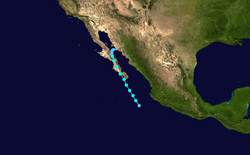 | |
| Duration | August 23 – August 26 |
|---|---|
| Peak intensity | 50 mph (85 km/h) (1-min) 998 mbar (hPa) |
A tropical wave moved off Africa on August 6, first spawning Tropical Storm Fay in the Atlantic before continuing into the eastern Pacific on August 17. It began to organize several days later, leading to the formation of a tropical depression by 12:00 UTC on August 23; six hours later, it intensified into Tropical Storm Julio. An area of high pressure over Mexico directed the nascent cyclone north-northwest, while moderate upper-level winds prevented Julio from strengthening beyond 50 mph (85 km/h). Around 00:00 UTC on August 25, the storm made landfall approximately 40 mi (65 km) west-southwest of La Paz, Baja California Sur, with winds of 45 mph (75 km/h). Slow weakening occurred as Julio entered the Gulf of California, and it fell to tropical depression intensity around 00:00 UTC on August 26 before degenerating to a remnant low eighteen hours later. The low drifted east before dissipating on the coast of mainland Mexico by 12:00 UTC on August 27.[25]
As Julio made landfall, it produced lightning and locally heavy rainfall,[26] which left more than a dozen communities isolated due to flooding. The flooding damaged several houses and killed one person.[27] Winds were generally light,[26] although strong enough to damage a few electrical poles and small buildings.[28] Moisture from Julio developed thunderstorms across Arizona, including one near Chandler which produced winds of 75 mph (120 km/h); the storm damaged ten small planes at Chandler Municipal Airport, as well as a hangar. The storms also dropped light rainfall, reaching over 1 inch (25 mm) in Gilbert, which caused flooding on Interstate 17.[29]
Tropical Storm Karina
| Tropical storm (SSHWS) | |
  | |
| Duration | September 2 – September 3 |
|---|---|
| Peak intensity | 40 mph (65 km/h) (1-min) 1000 mbar (hPa) |
A tropical wave, the same that spawned Hurricane Gustav while in the Atlantic, crossed Central America on August 28. Convection slowly increased as it moved westward, and an area of low pressure developed just south of the Mexico coastline on August 30. Despite strong easterly wind shear, shower and thunderstorm activity formed close enough to the center for the disturbance to become a tropical depression around 06:00 UTC on September 2. A brief relaxation in upper-level winds allowed the depression to intensify into Tropical Storm Karina six hours later before wind shear once again increased, leading to a steady weakening trend and degeneration to a remnant low by 18:00 UTC on September 3.[30]
Tropical Storm Lowell
| Tropical storm (SSHWS) | |
 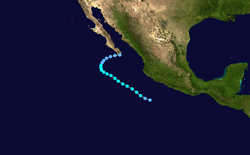 | |
| Duration | September 6 – September 11 |
|---|---|
| Peak intensity | 50 mph (85 km/h) (1-min) 998 mbar (hPa) |
A tropical wave emerged from Africa on August 19, the northern half of which spawned Hurricane Hanna while the second half continued west. It entered the East Pacific by August 28, interacting with a broad cyclonic gyre spawned by a pre-existing surface trough in the region. As the wave reached the western edge of the gyre, it formed an area of low pressure that further organized into a tropical depression around 12:00 UTC on September 6. It intensified into Tropical Storm Lowell twelve hours later. The cyclone moved along the western periphery of an anticyclone over Mexico, and this feature imparted strong upper-level winds on Lowell that limited its peak strength to 50 mph (85 km/h). Wind shear eventually slackened, but the storm progressed into a drier environment and began to weaken. After falling to tropical depression intensity, Lowell turned east and made landfall near Cabo San Lucas around 09:00 UTC on September 11. It opened up into an elongated surface trough nine hours later.[31]
Lowell made landfall as a tropical depression in Baja California but its effects where felt at more inland areas. In Michoacán, Sonora, and Sinaloa, flooding from Lowell's remnants left more than 26,500 people homeless. No deaths were reported.[32] Damage in Sonora totaled over 200 million pesos – US$15.5 million (value in 2008).[33]
Moisture from Lowell eventually joined with a cold front and the remnants of Hurricane Ike and caused significant damage. As this conglomeration of moisture traveled through the United States it caused extensive flooding in Illinois. In Chicago it broke flooding records dating back to 1871.[34]
Hurricane Marie
| Category 1 hurricane (SSHWS) | |
 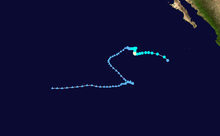 | |
| Duration | October 1 – October 6 |
|---|---|
| Peak intensity | 80 mph (130 km/h) (1-min) 984 mbar (hPa) |
On the heels of a record quiet September,[35] Marie developed on October 1 from a tropical wave that departed Africa nearly a month earlier on September 6. The wave moved west with little fanfare, crossing Central America on September 24 but still remaining poorly organized. An area of low pressure formed on September 28, and it began a gradual organization trend that led to the formation of a tropical depression around 06:00 UTC on October 1, and to the designation of Tropical Storm Marie six hours later. With light upper-level winds, Marie began a period of quick intensification on October 3, bringing it to hurricane strength at 18:00 UTC that afternoon and to a peak of 80 mph (130 km/h) the next morning. The hurricane soon began to enter cooler ocean temperatures, prompting a gradual decline in intensity before Marie degenerated to a remnant low around 00:00 UTC on October 7. The tenacious post-tropical cyclone meandered for nearly two weeks before being absorbed into the Intertropical Convergence Zone on October 19.[36]
Hurricane Norbert
| Category 4 hurricane (SSHWS) | |
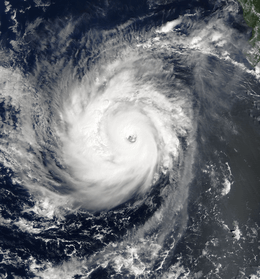 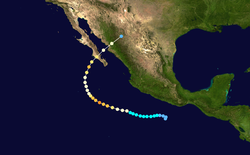 | |
| Duration | October 4 – October 12 |
|---|---|
| Peak intensity | 130 mph (215 km/h) (1-min) 945 mbar (hPa) |
The combination of two tropical waves resulted in the development of a tropical depression south of Mexico around 00:00 UTC on October 4. Steered by a mid-level ridge to its north, the depression gradually intensified, becoming Tropical Storm Norbert a day after formation and attaining hurricane strength around 06:00 UTC on October 7. The hurricane rounded the ridge and began to rapidly intensify, ultimately reaching its peak as a Category 4 hurricane with winds of 130 mph (215 km/h) near 18:00 UTC on October 8. An eyewall replacement cycle weakened Norbert to Category 1 strength late on October 9, but favorable environmental conditions allowed the system to re-attain major hurricane intensity around 06:00 UTC on October 11. Norbert made landfall just southeast of Bahia Magdalena, Baja California, around 16:30 UTC on October 11 at a slightly reduced strength of 105 mph (165 km/h). An increase in wind shear caused the system to weaken to 85 mph (140 km/h) as it made a second landfall east-southeast of Huatabampo, Sonora, around 04:00 UTC on October 12. Norbert continued northeast and rapidly dissipated over the mountains of northeastern Mexico by 18:00 UTC.[37]
Hurricane Norbert struck Mexico's Baja California peninsula with torrential rains and winds of up to 155 km/h. Strong winds bent palm trees along coastal areas. Some streets were in knee-deep water in the town of Puerto San Carlos. Norbert ripped off roofs, knocking down trees and left one person missing and more than 20,000 homes without electricity, local authorities say. Some 2850 people were housed in temporary shelters. Forty percent of homes were totally or partially damaged on the islands of Margarita and Magdalena, mainly having lost their roofs, said a report from state protection services. La Paz international airport suspended its activities at midday local time Saturday, but the tourist resort of Los Cabos remained open. Hotel reservations were down by around 40 per cent mainly in Los Cabos and Loreto, local tourism officials said.[38]
Norbert was a Category 2 hurricane at landfall, which made Norbert the first October hurricane to strike the western Baja California peninsula since Hurricane Pauline forty years prior, and Norbert was the stronger of the two.
Tropical Storm Odile
| Tropical storm (SSHWS) | |
  | |
| Duration | October 8 – October 12 |
|---|---|
| Peak intensity | 60 mph (95 km/h) (1-min) 997 mbar (hPa) |
A complex series of interactions between two tropical waves, a frontal system, and a pre-existing area of vorticity led to the formation of a tropical depression just west of El Salvador around 12:00 UTC on October 8. The system moved west-northwest as it developed, steered by a large ridge over Mexico. Light upper-level winds allowed the depression to intensify into Tropical Storm Odile by 06:00 UTC on October 9 and attain peak winds of 60 mph (95 km/h) by early the next day. After maintaining its intensity for over 24 hours, increasing southeasterly wind shear prompted a rapid weakening trend. Odile fell to tropical depression strength early on October 12 as it continued to parallel the coastline of Mexico, and it degenerated to a remnant low around 00:00 UTC on October 13. The post-tropical cyclone moved south-southwest and dissipated that day.[39]
Eighteen hours after it was named, a Tropical Storm Watch was issued from Punta Maldonado to Zihuatanejo.[40] It was replaced with a warning 12 hours later.[41] Before becoming a tropical wave, the precursor disturbance to Odile dumped heavy rainfall on Nicaragua, although any impact is unknown. Odile also caused heavy rain in Mexico. The system caused floods in Acapulco, which left 12 homes damaged.[42]
Tropical Depression Seventeen-E
| Tropical depression (SSHWS) | |
  | |
| Duration | October 23 – October 24 |
|---|---|
| Peak intensity | 35 mph (55 km/h) (1-min) 1008 mbar (hPa) |
A slow-moving tropical wave left Africa on September 30 and crossed into the East Pacific by October 16. Convection developed and persisted as it continued west, leading to the formation of a tropical depression well south of Mexico around 06:00 UTC on October 23. As the newly-formed cyclone reached the western periphery of a ridge over Mexico, it turned to the north. An approaching upper-level trough dictated the depression northwest early on October 24 while also imparting increasing upper-level winds; for this reason, deep convection never organized about the center of the system, and it failed to intensify into a tropical storm. By 18:00 UTC that day, it degenerated to a remnant area of low pressure. The post-tropical cyclone tracked west before dissipating early on October 28.[43]
Tropical Storm Polo
| Tropical storm (SSHWS) | |
  | |
| Duration | November 2 – November 5 |
|---|---|
| Peak intensity | 45 mph (75 km/h) (1-min) 1003 mbar (hPa) |
The final tropical cyclone of the 2008 season originated as a tropical wave that moved offshore Africa on October 15. The wave moved west and crossed Central America by October 29, subsequently merging with the ITCZ. A small area of low pressure developed along the wave axis, leading to the formation of a tropical depression around 12:00 UTC on November 2. Although the system never fully detached from the ITCZ, it intensified into Tropical Storm Polo twelve hours after formation, at an unusually low latitude. The development of a tiny eye-like feature signified the storm's peak strength of 45 mph (75 km/h) before increasing upper-level winds caused Polo to degenerate to an open trough by 06:00 UTC on November 5.[44]
Storm names
The following names were used for named storms that formed in the East Pacific in 2008. The names not retired from this list were used again in the 2014 season. This was the same list that was used in the 2002 season, with the exception of Karina, which replaced Kenna. Names that weren't used are marked in gray.[45]
|
For storms that form in the Central Pacific Hurricane Center's area of responsibility, encompassing the area between 140 degrees west and the International Date Line, all names are used in a series of four rotating lists. The only name used was Kika.[45]
|
|
|
|
|
|
|
|
Retirement
In the spring of 2009, at the 31st session of the RA IV hurricane committee, the World Meteorological Organization retired the name Alma from the Eastern Pacific naming list due to the flooding, damage, and deaths it caused in Central America, in particular Costa Rica, and it will never be used again for a Pacific hurricane. It was replaced with Amanda for the 2014 season.[46]
Season effects
This is a table of all the storms that have formed in the 2008 Pacific hurricane season. It includes their duration, names, landfall(s), denoted in parentheses, damages, and death totals. Deaths in parentheses are additional and indirect (an example of an indirect death would be a traffic accident), but were still related to that storm. Damage and deaths include totals while the storm was extratropical, a wave, or a low, and all the damage figures are in 2008 US dollars.
| Saffir–Simpson scale | ||||||
| TD | TS | C1 | C2 | C3 | C4 | C5 |
| Storm name |
Dates active | Storm category
at peak intensity |
Max 1-min wind mph (km/h) |
Min. press. (mbar) |
Areas affected | Damage (USD) |
Deaths | Refs | ||
|---|---|---|---|---|---|---|---|---|---|---|
| Alma[47] | May 29 – 30 | Tropical storm | 65 (100) | 994 | Central America | $35 million | 4 (7) | |||
| Boris[48] | June 27 – July 4 | Category 1 hurricane | 80 (130) | 985 | None | None | None | |||
| Cristina | June 27 – 30 | Tropical storm | 50 (85) | 999 | None | None | None | |||
| Douglas | July 1 – 4 | Tropical storm | 40 (65) | 1003 | Northwestern Mexico, Baja California Peninsula | None | None | |||
| Five-E | July 5 – 7 | Tropical depression | 40 (65) | 1005 | Southwestern Mexico, Western Mexico | $2.2 million | 1 (1) | |||
| Elida | July 11 – 19 | Category 2 hurricane | 105 (165) | 970 | Southwestern Mexico, Hawaii | None | None | |||
| Fausto | July 15 – 22 | Category 1 hurricane | 90 (150) | 977 | Clarion Island, Socorro Island | Minimal | None | |||
| Genevieve | July 21 – 27 | Category 1 hurricane | 75 (120) | 987 | Hawaii | None | None | |||
| Hernan | August 6 – 12 | Category 3 hurricane | 120 (195) | 955 | Hawaii | None | None | |||
| Kika | August 7 – 16 | Tropical storm | 40 (65) | 1007 | None | None | None | |||
| Iselle | August 13 – 16 | Tropical storm | 50 (85) | 999 | None | None | None | |||
| Julio | August 23 – 26 | Tropical storm | 50 (85) | 998 | Northwestern Mexico, Baja California Sur, Sinaloa and Arizona | $1 million | 2 | |||
| Karina | September 2 – 3 | Tropical storm | 40 (65) | 1000 | Socorro Island | None | None | |||
| Lowell | September 6 – 11 | Tropical storm | 50 (85) | 998 | Northwestern Mexico, Baja California Peninsula, Southwestern United States | $15.5 million | 6 | |||
| Marie | October 1 – 6 | Category 1 hurricane | 80 (130) | 984 | None | None | None | |||
| Norbert | October 4 – 12 | Category 4 hurricane | 130 (215) | 945 | Northwestern Mexico, Baja California Sur, Sonora, Sinaloa | $98.5 million | 25 | |||
| Odile | October 8 – 12 | Tropical storm | 60 (95) | 997 | Central America, Nicaragua, Honduras, El Salvador, Guatemala, Southwestern Mexico | Minimal | None | |||
| Seventeen-E | October 23 – 24 | Tropical depression | 35 (55) | 1008 | None | None | None | |||
| Polo | November 2 – 5 | Tropical storm | 45 (75) | 1002 | None | None | None | |||
| Season aggregates | ||||||||||
| 19 systems | May 29 – November 5 | 130 (215) | 945 | $153 million | 38 (8) | |||||
See also
- List of Pacific hurricanes
- Pacific hurricane season
- 2008 Atlantic hurricane season
- 2008 Pacific typhoon season
- 2008 North Indian Ocean cyclone season
- South-West Indian Ocean cyclone seasons: 2007–08, 2008–09
- Australian region cyclone seasons: 2007–08, 2008–09
- South Pacific cyclone seasons: 2007–08, 2008–09
References
- "Previous Tropical Systems in the Central Pacific". Central Pacific Hurricane Center. Archived from the original on 22 December 2008. Retrieved 2008-12-01.
- "Background Information: East Pacific Hurricane Season". Climate Prediction Center. College Park, Maryland: National Oceanic and Atmospheric Administration. May 3, 2008. Archived from the original on May 3, 2007. Retrieved June 26, 2018.
- National Hurricane Center; Hurricane Research Division; Central Pacific Hurricane Center. "The Northeast and North Central Pacific hurricane database 1949–2019". United States National Oceanic and Atmospheric Administration's National Weather Service. A guide on how to read the database is available here.
- Pronostico de Huracanes del 2008 (PDF) (Report) (in Spanish). Secretaria de Marina Direccion de Meteorologia Maritima. May 16, 2008. Retrieved June 27, 2018.
- Climate Prediction Center, NOAA (May 22, 2008). "NOAA: 2008 Tropical Eastern North Pacific Hurricane Outlook". National Oceanic and Atmospheric Administration. Archived from the original on 2008-06-18. Retrieved June 26, 2018.
- Central Pacific Hurricane Center (May 19, 2008). "NOAA Expects Slightly Below Average Central Pacific Hurricane Season" (PDF). National Oceanic and Atmospheric Administration. Archived from the original (PDF) on June 26, 2008. Retrieved June 26, 2018.
- Eric S. Blake; Richard J. Pasch (September 29, 2009). "Eastern North Pacific Hurricane Season of 2008". National Hurricane Center. American Meteorological Society. 138 (3): 1. doi:10.1175/2009MWR3093.1.
- Daniel P. Brown (July 7, 2008). Tropical Cyclone Report: Tropical Storm Alma (PDF) (Report). Miami, Florida: National Hurricane Center. pp. 1, 4. Retrieved July 11, 2017.
- Eric S. Blake (October 17, 2008). Tropical Cyclone Report: Hurricane Boris (PDF) (Report). Miami, Florida: National Hurricane Center. pp. 1, 3. Retrieved July 11, 2017.
- Richard J. Pasch (February 18, 2009). Tropical Cyclone Report: Tropical Storm Cristina (PDF) (Report). Miami, Florida: National Hurricane Center. pp. 1, 3. Retrieved July 13, 2017.
- Lixion A. Avila (September 16, 2008). Tropical Cyclone Report: Tropical Storm Douglas (PDF) (Report). Miami, Florida: National Hurricane Center. pp. 1, 3. Retrieved July 13, 2017.
- Oscar Gutierrez; Justin Miranda; Edgar Avila Perez (July 2, 2008). "Ocasiona tormenta tropical Douglas intensas lluvias". El Universal (in Spanish). Retrieved September 18, 2008.
- Staff Writer (July 3, 2008). "Douglas Continues to Weaken". Bajan Insider. Archived from the original on October 8, 2008. Retrieved June 14, 2009.
- Richard D. Knabb (September 9, 2008). Tropical Cyclone Report: Tropical Depression Five-E (PDF) (Report). Miami, Florida: National Hurricane Center. Retrieved July 16, 2017.
- Richard J. Pasch (July 6, 2008). Tropical Depression Five-E Discussion Number 4 (Report). Miami, Florida: National Hurricane Center. Retrieved July 16, 2017.
- James L. Franklin (September 28, 2008). Tropical Cyclone Report: Hurricane Elida (PDF) (Report). Miami, Florida: National Hurricane Center. pp. 1, 2, 4, 5. Retrieved July 18, 2017.
- Lixion A. Avila (July 16, 2008). Hurricane Elida Discussion Number 20 (Report). Miami, Florida: National Hurricane Center. Retrieved July 18, 2017.
- John L. Beven II (November 19, 2008). Tropical Cyclone Report: Hurricane Fausto (PDF) (Report). Miami, Florida: National Hurricane Center. pp. 1, 4. Retrieved July 19, 2017.
- David P. Roberts; Richard J. Pasch (July 21, 2008). Hurricane Fausto Discussion Number 21 (Report). Miami, Florida: National Hurricane Center. Retrieved July 19, 2017.
- Jessica S. Clark; Jamie R. Rhome (December 16, 2008). Tropical Cyclone Report: Hurricane Genevieve (PDF) (Report). Miami, Florida: National Hurricane Center. pp. 1, 2, 4, 5. Retrieved July 24, 2017.
- Eric S. Blake (July 25, 2008). Hurricane Genevieve Discussion Number 18 (Report). Miami, Florida: National Hurricane Center. Retrieved July 24, 2017.
- Daniel P. Brown (October 13, 2008). Tropical Cyclone Report: Hurricane Hernan (PDF) (Report). Miami, Florida: National Hurricane Center. Retrieved June 22, 2018.
- Jeff Powell. Tropical Cyclone Report: Tropical Storm Kika (PDF) (Report). Central Pacific Hurricane Center. Retrieved June 9, 2019.
- Eric S. Blake (December 5, 2008). Tropical Cyclone Report: Tropical Storm Iselle (PDF) (Report). Miami, Florida: National Hurricane Center. Retrieved June 22, 2018.
- Richard J. Pasch (February 10, 2009). Tropical Cyclone Report: Tropical Storm Julio (PDF) (Report). Miami, Florida: National Hurricane Center. Retrieved June 22, 2018.
- Ignacio Martinez (2008-08-25). "Tropical Storm Julio expected to weaken in Mexico". Associated Press. Retrieved 2008-08-26.
- Gladys Rodríguez; et al. (2008-08-27). "'Julio' leaves 1 dead in BCS and Sonora". El Universal (in Spanish). Retrieved 2008-08-27.
- Staff Writer (2008-08-25). "Julio weakens to tropical depression in Mexico". Associated Press. Retrieved 2008-08-26.
- Alyson Zepeda; Megan Boehnke (2008-08-26). "Monsoon storm brings rain, wind, thunder". The Arizona Republic. Retrieved 2008-08-28.
- Lixion A. Avila (October 7, 2008). Tropical Cyclone Report: Tropical Storm Karina (PDF) (Report). Miami, Florida: National Hurricane Center. Retrieved June 24, 2018.
- Robbie J. Berg (December 2, 2008). Tropical Cyclone Report: Tropical Storm Lowell (PDF) (Report). Miami, Florida: National Hurricane Center. Retrieved June 24, 2018.
- "Monthly Tropical Weather Summary". National Hurricane Center. 2008-10-01. Archived from the original on 3 October 2008. Retrieved 2008-10-02.
- http://www.nhc.noaa.gov/data/tcr/EP132008_Lowell.pdf
- "Chicago seeks aid after worst rain in at least 137 years". CNN. 2008-09-14. Archived from the original on 18 December 2008. Retrieved 17 December 2008.
- Hurricane Specialists Unit (October 1, 2008). Monthly Tropical Weather Summary: September (Report). Miami, Florida: National Hurricane Center. Retrieved June 24, 2018.
- Stacy R. Stewart (November 16, 2008). Tropical Cyclone Report: Hurricane Marie (PDF) (Report). Miami, Florida: National Hurricane Center. Retrieved June 24, 2018.
- James L. Franklin (January 7, 2009). Tropical Cyclone Report: Hurricane Norbert (PDF) (Report). Miami, Florida: National Hurricane Center. Retrieved June 25, 2018.
- Hurricane tears into Mexico
- John L. Beven II (November 19, 2008). Tropical Cyclone Report: Tropical Storm Odile (PDF) (Report). Miami, Florida: National Hurricane Center. Retrieved June 25, 2018.
- http://www.nhc.noaa.gov/archive/2008/ep16/ep162008.public.006.shtml?
- http://www.nhc.noaa.gov/archive/2008/ep16/ep162008.public.008.shtml?
- (in Spanish) http://www2.esmas.com/noticierostelevisa/mexico/017485/tormenta-odile-deja-daos-materiales-acapulco
- Michael J. Brennan (November 23, 2008). Tropical Cyclone Report: Tropical Depression Seventeen-E (PDF) (Report). Miami, Florida: National Hurricane Center. Retrieved June 25, 2018.
- Robbie J. Berg (December 9, 2008). Tropical Cyclone Report: Tropical Storm Polo (PDF) (Report). Miami, Florida: National Hurricane Center. Retrieved June 25, 2018.
- "Tropical Cyclone Naming". World Meteorological Organization. Retrieved June 26, 2018.
- "Four Hurricane Names Retired From List of Storms" (Press release). United States National Oceanic and Atmospheric Administration. May 1, 2009. Archived from the original on June 21, 2014. Retrieved June 21, 2014.
- Daniel P Brown (2008-07-07). "Tropical Storm Alma Tropical Cyclone Report" (PDF). NHC. Archived (PDF) from the original on 9 September 2008. Retrieved 2008-08-23.
- Blake, Eric S (July 7, 2008). Hurricane Boris — June 27 – July 4, 2008 (PDF) (Tropical Cyclone Report). United States National Oceanic and Atmospheric Administration's National Weather Service. Archived (PDF) from the original on August 24, 2014. Retrieved August 24, 2014.